Ram 1500 2020 Owner's Manual
Manufacturer: RAM, Model Year: 2020, Model line: 1500, Model: Ram 1500 2020Pages: 674, PDF Size: 32.69 MB
Page 281 of 674
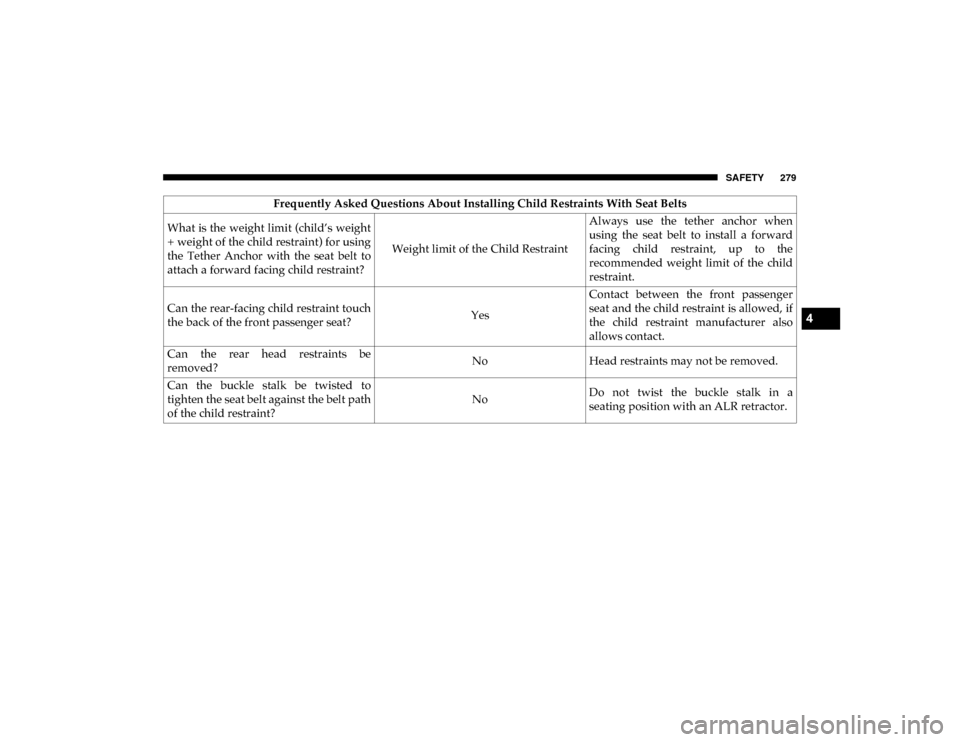
SAFETY 279
Frequently Asked Questions About Installing Child Restraints With Seat Belts
What is the weight limit (child’s weight
+ weight of the child restraint) for using
the Tether Anchor with the seat belt to
attach a forward facing child restraint? Weight limit of the Child RestraintAlways use the tether anchor when
using the seat belt to install a forward
facing child restraint, up to the
recommended weight limit of the child
restraint.
Can the rear-facing child restraint touch
the back of the front passenger seat? YesContact between the front passenger
seat and the child restraint is allowed, if
the child restraint manufacturer also
allows contact.
Can the rear head restraints be
removed? No
Head restraints may not be removed.
Can the buckle stalk be twisted to
tighten the seat belt against the belt path
of the child restraint? No
Do not twist the buckle stalk in a
seating position with an ALR retractor.
4
2020_DT_1500_OM_US.book Page 279
Page 282 of 674

280 SAFETY
Installing A Child Restraint With A Switchable Automatic
Locking Retractor (ALR):
Child restraint systems are designed to be secured in vehicle
seats by lap belts or the lap belt portion of a lap/shoulder
belt.
1. Place the child seat in the center of the seating position.For some second row seats, you may need to recline the
seat and/or raise the head restraint (if adjustable) to get a
better fit. If the rear seat can be moved forward and rear -
ward in the vehicle, you may wish to move it to its
rear-most position to make room for the child seat. You
may also move the front seat forward to allow more room
for the child seat.
2. Pull enough of the seat belt webbing from the retractor to pass it through the belt path of the child restraint. Do not
twist the belt webbing in the belt path. 3. Slide the latch plate into the buckle until you hear a
“click.”
4. Pull on the webbing to make the lap portion tight against the child seat.
5. To lock the seat belt, pull down on the shoulder part of the belt until you have pulled all the seat belt webbing out
of the retractor. Then, allow the webbing to retract back
into the retractor. As the webbing retracts, you will hear
a clicking sound. This means the seat belt is now in the
Automatic Locking mode.
6. Try to pull the webbing out of the retractor. If it is locked, you should not be able to pull out any webbing. If the
retractor is not
locked, repeat step 5.
7. Finally, pull up on any excess webbing to tighten the lap portion around the child restraint while you push the
child restraint rearward and downward into the vehicle
seat.
8. If the child restraint has a top tether strap and the seating position has a top tether anchorage, connect the tether
strap to the anchorage and tighten the tether strap. Refer
to “Installing Child Restraints Using the Top Tether
Anchorage” in this section for directions to attach a tether
anchor.
WARNING!
• Improper installation or failure to properly secure a child restraint can lead to failure of the restraint. The
child could be badly injured or killed.
• Follow the child restraint manufacturer’s directions exactly when installing an infant or child restraint.
2020_DT_1500_OM_US.book Page 280
Page 283 of 674

SAFETY 281
9. Test that the child restraint is installed tightly by pullingback and forth on the child seat at the belt path. It should
not move more than 1 inch (25.4 mm) in any direction.
Any seat belt system will loosen with time, so check the belt
occasionally, and pull it tight if necessary.
Installing Child Restraints Using The Top Tether
Anchorage The top tether anchorages in this vehicle are tether strap
loops located between the rear glass and the back of the rear
seat. There is a tether strap loop located behind each seating
position. Follow the steps below to attach the tether strap of
the child restraint.
Right Or Left Outboard Seats:
1. Reach between the rear seat and rear glass to access the
tether strap loop.
2. Place a child restraint on the seat and adjust the tether strap so that it will reach over the seat back, through the
space between the head restraint and the seat back,
through the tether strap loop behind the seat and over to
the tether strap loop behind the center seat.
WARNING!
Do not attach a tether strap for a rear-facing car seat to any
location in front of the car seat, including the seat frame or a
tether anchorage. Only attach the tether strap of a
rear-facing car seat to the tether anchorage that is approved
for that seating position, located behind the top of the
vehicle seat. See the section “Lower Anchors and Tethers
for CHildren (LATCH) Restraint System” for the location of
approved tether anchorages in your vehicle.
WARNING!
Never place a rear-facing child restraint in front of an air
bag. A deploying Passenger Front Air Bag can cause
death or serious injury to a child 12 years or younger,
including a child in a rear-facing child restraint.
4
2020_DT_1500_OM_US.book Page 281
Page 284 of 674
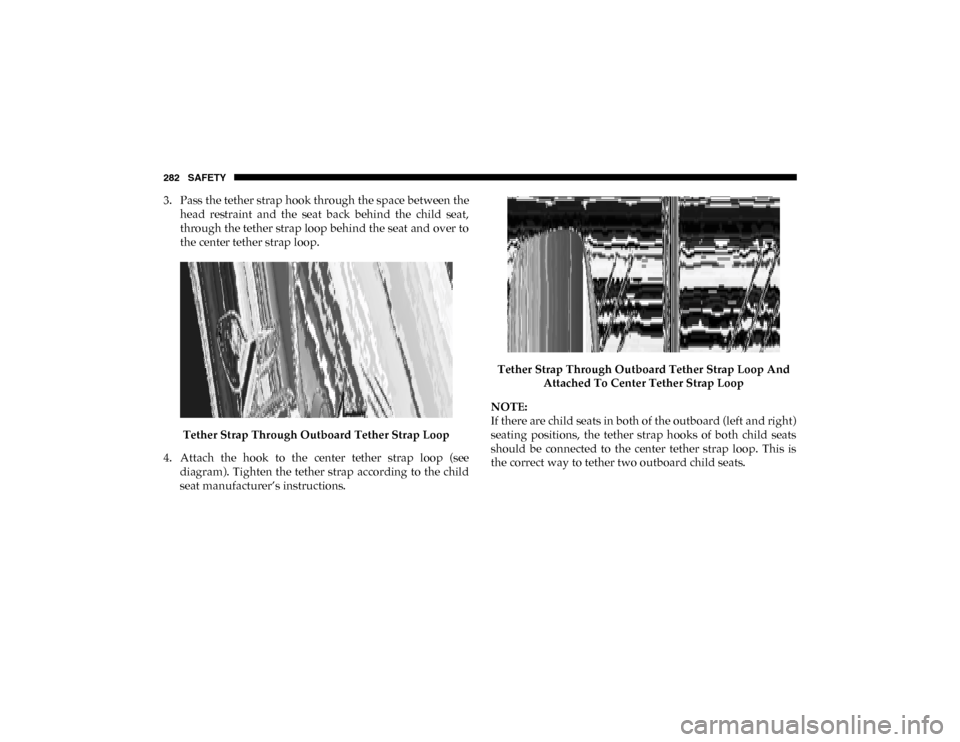
282 SAFETY
3. Pass the tether strap hook through the space between thehead restraint and the seat back behind the child seat,
through the tether strap loop behind the seat and over to
the center tether strap loop.
Tether Strap Through Outboard Tether Strap Loop
4. Attach the hook to the center tether strap loop (see diagram). Tighten the tether strap according to the child
seat manufacturer’s instructions. Tether Strap Through Outboard Tether Strap Loop And
Attached To Center Tether Strap Loop
NOTE:
If there are child seats in both of the outboard (left and right)
seating positions, the tether strap hooks of both child seats
should be connected to the center tether strap loop. This is
the correct way to tether two outboard child seats.
2020_DT_1500_OM_US.book Page 282
Page 285 of 674
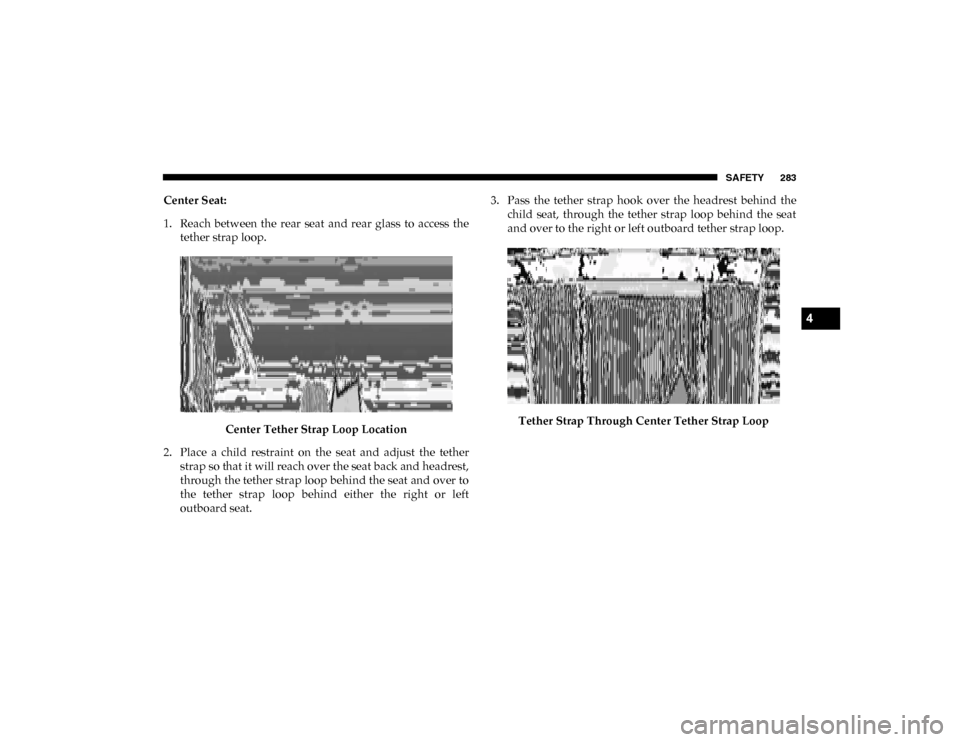
SAFETY 283
Center Seat:
1. Reach between the rear seat and rear glass to access thetether strap loop.
Center Tether Strap Loop Location
2. Place a child restraint on the seat and adjust the tether strap so that it will reach over the seat back and headrest,
through the tether strap loop behind the seat and over to
the tether strap loop behind either the right or left
outboard seat. 3. Pass the tether strap hook over the headrest behind the
child seat, through the tether strap loop behind the seat
and over to the right or left outboard tether strap loop.
Tether Strap Through Center Tether Strap Loop
4
2020_DT_1500_OM_US.book Page 283
Page 286 of 674
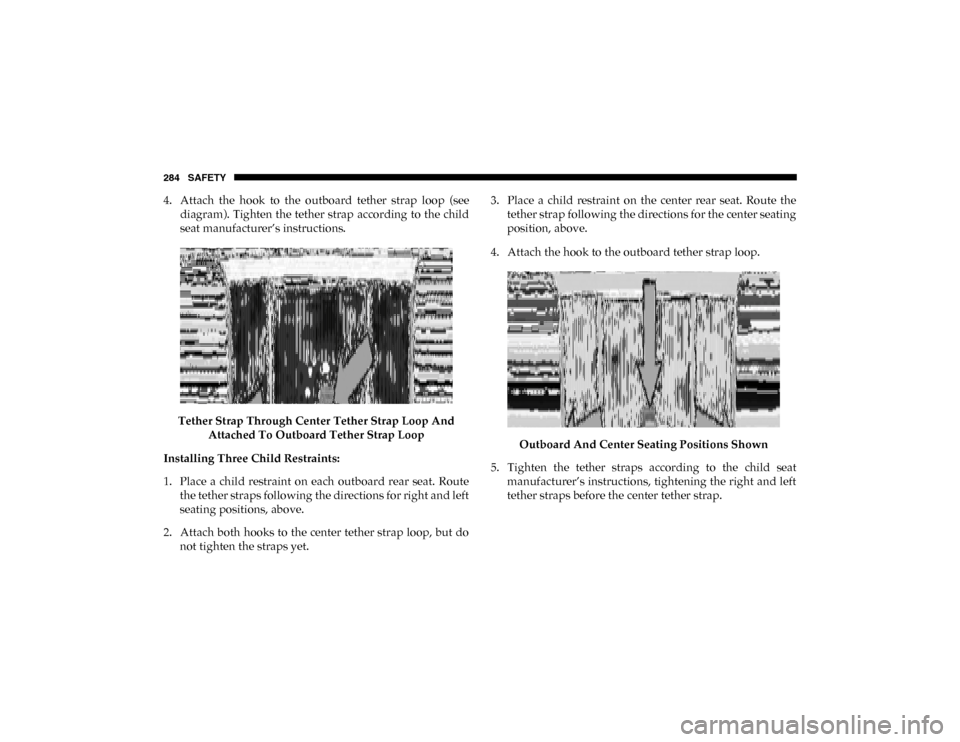
284 SAFETY
4. Attach the hook to the outboard tether strap loop (seediagram). Tighten the tether strap according to the child
seat manufacturer’s instructions.
Tether Strap Through Center Tether Strap Loop And Attached To Outboard Tether Strap Loop
Installing Three Child Restraints:
1. Place a child restraint on each outboard rear seat. Route the tether straps following the directions for right and left
seating positions, above.
2. Attach both hooks to the center tether strap loop, but do not tighten the straps yet. 3. Place a child restraint on the center rear seat. Route the
tether strap following the directions for the center seating
position, above.
4. Attach the hook to the outboard tether strap loop.
Outboard And Center Seating Positions Shown
5. Tighten the tether straps according to the child seat manufacturer’s instructions, tightening the right and left
tether straps before the center tether strap.
2020_DT_1500_OM_US.book Page 284
Page 287 of 674
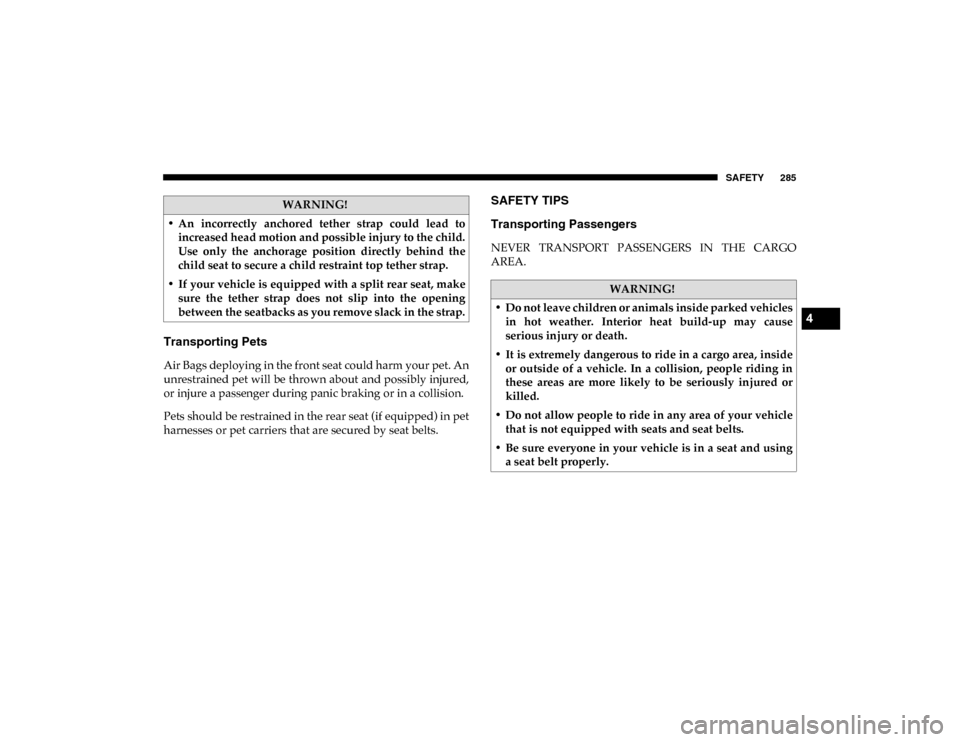
SAFETY 285
Transporting Pets
Air Bags deploying in the front seat could harm your pet. An
unrestrained pet will be thrown about and possibly injured,
or injure a passenger during panic braking or in a collision.
Pets should be restrained in the rear seat (if equipped) in pet
harnesses or pet carriers that are secured by seat belts.
SAFETY TIPS
Transporting Passengers
NEVER TRANSPORT PASSENGERS IN THE CARGO
AREA.
WARNING!
• An incorrectly anchored tether strap could lead to increased head motion and possible injury to the child.
Use only the anchorage position directly behind the
child seat to secure a child restraint top tether strap.
• If your vehicle is equipped with a split rear seat, make sure the tether strap does not slip into the opening
between the seatbacks as you remove slack in the strap.
WARNING!
• Do not leave children or animals inside parked vehicles in hot weather. Interior heat build-up may cause
serious injury or death.
• It is extremely dangerous to ride in a cargo area, inside or outside of a vehicle. In a collision, people riding in
these areas are more likely to be seriously injured or
killed.
• Do not allow people to ride in any area of your vehicle that is not equipped with seats and seat belts.
• Be sure everyone in your vehicle is in a seat and using a seat belt properly.
4
2020_DT_1500_OM_US.book Page 285
Page 288 of 674
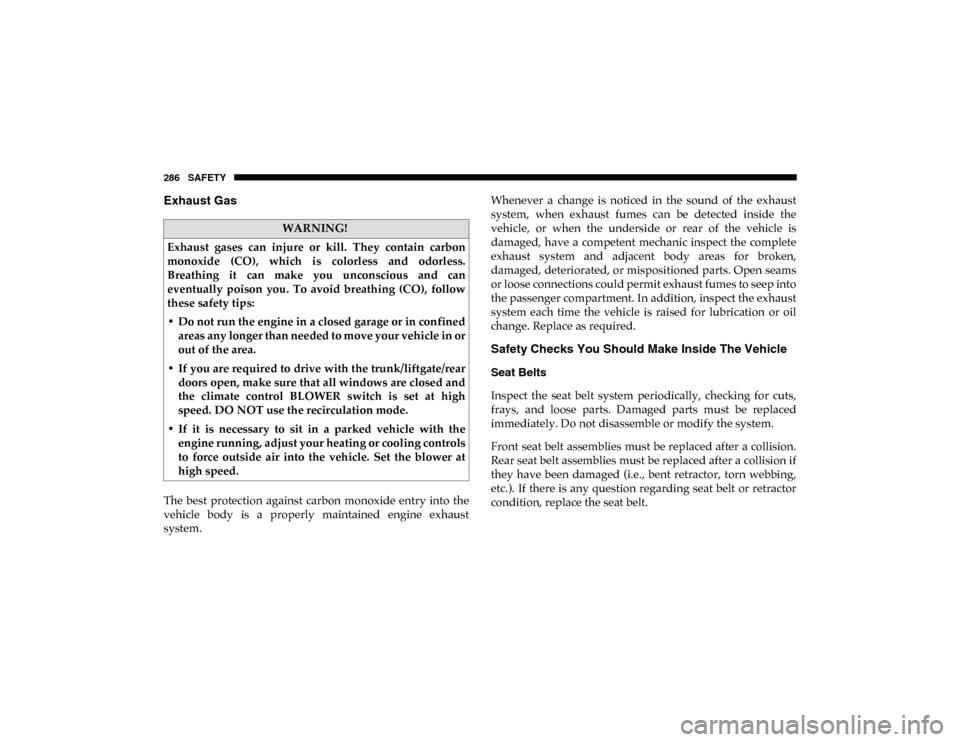
286 SAFETY
Exhaust Gas
The best protection against carbon monoxide entry into the
vehicle body is a properly maintained engine exhaust
system.Whenever a change is noticed in the sound of the exhaust
system, when exhaust fumes can be detected inside the
vehicle, or when the underside or rear of the vehicle is
damaged, have a competent mechanic inspect the complete
exhaust system and adjacent body areas for broken,
damaged, deteriorated, or mispositioned parts. Open seams
or loose connections could permit exhaust fumes to seep into
the passenger compartment. In addition, inspect the exhaust
system each time the vehicle is raised for lubrication or oil
change. Replace as required.
Safety Checks You Should Make Inside The Vehicle
Seat Belts
Inspect the seat belt system periodically, checking for cuts,
frays, and loose parts. Damaged parts must be replaced
immediately. Do not disassemble or modify the system.
Front seat belt assemblies must be replaced after a collision.
Rear seat belt assemblies must be replaced after a collision if
they have been damaged (i.e., bent retractor, torn webbing,
etc.). If there is any question regarding seat belt or retractor
condition, replace the seat belt.
WARNING!
Exhaust gases can injure or kill. They contain carbon
monoxide (CO), which is colorless and odorless.
Breathing it can make you unconscious and can
eventually poison you. To avoid breathing (CO), follow
these safety tips:
• Do not run the engine in a closed garage or in confined areas any longer than needed to move your vehicle in or
out of the area.
• If you are required to drive with the trunk/liftgate/rear doors open, make sure that all windows are closed and
the climate control BLOWER switch is set at high
speed. DO NOT use the recirculation mode.
• If it is necessary to sit in a parked vehicle with the engine running, adjust your heating or cooling controls
to force outside air into the vehicle. Set the blower at
high speed.
2020_DT_1500_OM_US.book Page 286
Page 289 of 674
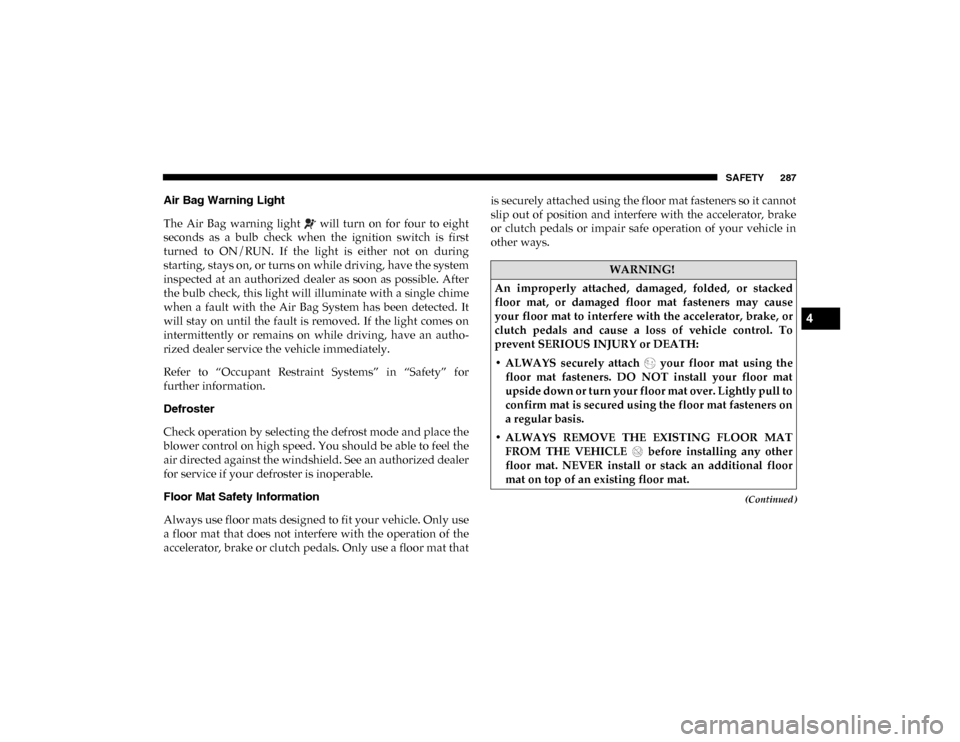
SAFETY 287
(Continued)
Air Bag Warning Light
The Air Bag warning light will turn on for four to eight
seconds as a bulb check when the ignition switch is first
turned to ON/RUN. If the light is either not on during
starting, stays on, or turns on while driving, have the system
inspected at an authorized dealer as soon as possible. After
the bulb check, this light will illuminate with a single chime
when a fault with the Air Bag System has been detected. It
will stay on until the fault is removed. If the light comes on
intermittently or remains on while driving, have an autho-
rized dealer service the vehicle immediately.
Refer to “Occupant Restraint Systems” in “Safety” for
further information.
Defroster
Check operation by selecting the defrost mode and place the
blower control on high speed. You should be able to feel the
air directed against the windshield. See an authorized dealer
for service if your defroster is inoperable.
Floor Mat Safety Information
Always use floor mats designed to fit your vehicle. Only use
a floor mat that does not interfere with the operation of the
accelerator, brake or clutch pedals. Only use a floor mat that is securely attached using the floor mat fasteners so it cannot
slip out of position and interfere with the accelerator, brake
or clutch pedals or impair safe operation of your vehicle in
other ways.
WARNING!
An improperly attached, damaged, folded, or stacked
floor mat, or damaged floor mat fasteners may cause
your floor mat to interfere with the accelerator, brake, or
clutch pedals and cause a loss of vehicle control. To
prevent SERIOUS INJURY or DEATH:
• ALWAYS securely attach your floor mat using the floor mat fasteners. DO NOT install your floor mat
upside down or turn your floor mat over. Lightly pull to
confirm mat is secured using the floor mat fasteners on
a regular basis.
• ALWAYS REMOVE THE EXISTING FLOOR MAT FROM THE VEHICLE before installing any other
floor mat. NEVER install or stack an additional floor
mat on top of an existing floor mat.
4
2020_DT_1500_OM_US.book Page 287
Page 290 of 674

288 SAFETY
(Continued)
• ONLY install floor mats designed to fit your vehicle.NEVER install a floor mat that cannot be properly
attached and secured to your vehicle. If a floor mat
needs to be replaced, only use a FCA approved floor
mat for the specific make, model, and year of your
vehicle.
• ONLY use the driver’s side floor mat on the driver’s side floor area. To check for interference, with the
vehicle properly parked with the engine off, fully
depress the accelerator, the brake, and the clutch pedal
(if present) to check for interference. If your floor mat
interferes with the operation of any pedal, or is not
secure to the floor, remove the floor mat from the
vehicle and place the floor mat in your trunk.
• ONLY use the passenger’s side floor mat on the passenger’s side floor area.
• ALWAYS make sure objects cannot fall or slide into the driver’s side floor area when the vehicle is moving.
Objects can become trapped under accelerator, brake,
or clutch pedals and could cause a loss of vehicle
control.
WARNING! (Continued)
• NEVER place any objects under the floor mat (e.g.,
towels, keys, etc.). These objects could change the posi -
tion of the floor mat and may cause interference with
the accelerator, brake, or clutch pedals.
• If the vehicle carpet has been removed and re-installed, always properly attach carpet to the floor and check the
floor mat fasteners are secure to the vehicle carpet.
Fully depress each pedal to check for interference with
the accelerator, brake, or clutch pedals then re-install
the floor mats.
• It is recommended to only use mild soap and water to clean your floor mats. After cleaning, always check
your floor mat has been properly installed and is
secured to your vehicle using the floor mat fasteners by
lightly pulling mat.
WARNING! (Continued)
2020_DT_1500_OM_US.book Page 288